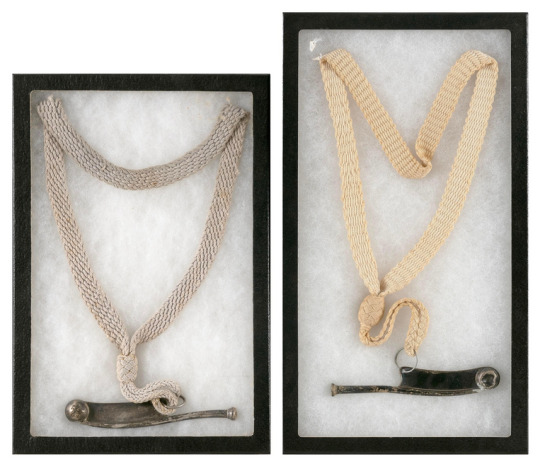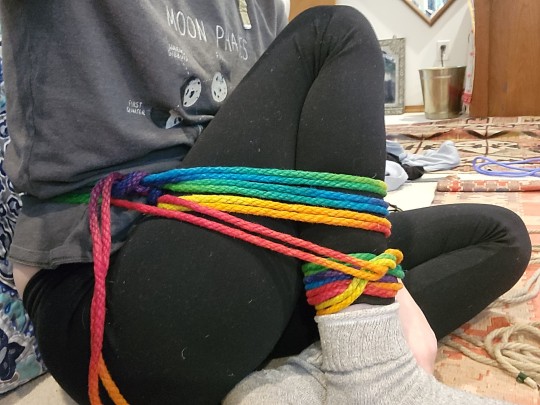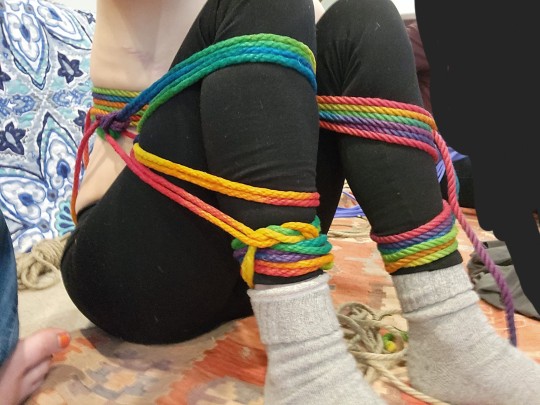#RopeWork
Explore tagged Tumblr posts
Text
picked up my rope for the first time in a long time
#bd/sm kink#bd/sm community#shibari#ropework#bdsmkink#bd/sm rope#ropeplay#bd/sm switch#bd/sm dom#bd/sm brat
75 notes
·
View notes
Text

Silver Bosun calls, early 20th century
#naval artifacts#bosun's call#silver#lanyard#ropework#sailors handicraft#early 20th century#age of steam
75 notes
·
View notes
Text
Jute
hums with purpose,
a quiet demand:
hold here, yield there—
an ache, a stretch, a choice.
I am not passive in this stillness.
Every muscle sings its own intention,
every shift of flesh a dialogue
between surrender and control.
To be bound is to be free of the earth,
but tethered to the self,
the weight of my own body
a responsibility I cannot escape.
I balance the art of vanishing
with the mastery of staying whole.
2 notes
·
View notes
Text
delightful rope workshop this weekend! I did my first suspension - didn't get pics of the suspension, but I did get pics of some of the other ties I did
this one was fun, I was able to scoot myself across the floor using my arms >:3 like an egg with arms


I got hogtied and had lots of fun wriggling around, but I didn't get a picture of that. I did photograph a fun chest harness I did to find a way to use the double coin knot:

20 notes
·
View notes
Text

11. Wicked Horns
Unfortunately, we're struggling with being presentable these days. Full image found here
👇
#yeehawgust#digital illustration#podcast#drawing#sketch#demon girl#sr4d#ttrpg#shibari#ropework#the possibilities are endless#artwork
8 notes
·
View notes
Text

A sailor made macrame ropework cane, 19th century
57 notes
·
View notes
Text
there's a monthly rope workshop in my area that I went to for the first time this weekend, lots of fun! got me inspired to do more self-ties, so I might be more active on here
I immediately forgot the name of this tie, but it starts with a single column tie and then attaches to the rest of the leg


and here's another variation, this time including the torso


then the other leg


having both legs tied to my torso makes rocking to stim extremely satisfying
also learned how to make a hip harness (which I forgot to take photos of) and a chest harness (which I did take photos of)



still working on figuring out the optimal chest harness placement that doesn't cover up the scars or the nips (nips for aesthetics, scars for safety and aesthetics)
24 notes
·
View notes
Text
Jamie Harris Explains Rope Access for Safe High Work

Working at heights is never simple, but rope access has made it safer and more efficient. Jamie Harris, a trained Rope Access Technician based in Cardiff and Dinas Powys, has hands-on experience in this specialized field. With expertise in Non-Destructive Testing (NDT), he ensures safety and precision while working at great heights. In this blog, Jamie explains what rope access is, why it’s important, and how it ensures safety during high-level tasks.
What is Rope Access?
Rope access is a method used to reach high or difficult areas using ropes and climbing techniques. It is commonly used in industries such as construction, maintenance, and inspections. Instead of relying on scaffolding or lifts, technicians use ropes and harnesses to perform their tasks securely.
This technique allows for:
Quick and safe access to tall structures
Minimal impact on surroundings
Cost-effective solutions compared to scaffolding
High flexibility for different industries
Why is Rope Access Important?
Safety and efficiency are the main reasons why companies prefer rope access. Jamie Harris emphasizes that this method reduces the risk of accidents while also being quicker to set up. It allows workers to inspect, repair, or maintain structures with minimal disruption.
Key benefits include:
Reduced worksite hazards
Faster completion of tasks
Lower costs compared to traditional access methods
Less environmental impact
Ensuring Safety in Rope Access
Safety is the top priority for any rope access technician. Jamie Harris follows strict guidelines to ensure safe operations. Rope access technicians undergo extensive training to handle different working conditions.
Key Safety Measures:
Use of double-rope systems for extra security
Regular equipment checks and maintenance
Strict training and certification requirements
Emergency rescue procedures in place
By following these steps, rope access technicians can work efficiently while minimizing risks.
Non-Destructive Testing (NDT) and Rope Access
Jamie Harris specializes in Non-Destructive Testing (NDT), a crucial process for inspecting structures without causing damage. With rope access, NDT becomes easier, especially for high-rise buildings, bridges, and towers.
Common NDT Methods in Rope Access:
Ultrasonic Testing – Detects hidden cracks and flaws in materials
Magnetic Particle Testing – Identifies surface defects in metal structures
Visual Inspection – Checks for visible signs of wear and tear
Combining NDT with rope access ensures that inspections are done safely and effectively, reducing downtime for businesses.
Industries That Benefit from Rope Access
Rope access is widely used across various industries. Jamie has worked in multiple sectors, applying his skills to ensure safety and efficiency.
Industries That Rely on Rope Access:
Construction – Inspections, maintenance, and installations on high-rise buildings
Oil & Gas – Rig inspections and maintenance
Renewable Energy – Wind turbine inspections and repairs
Bridges & Infrastructure – Structural assessments and repairs
By offering a quick and safe solution, rope access continues to be a valuable method in these industries.
Becoming a Rope Access Technician
Interested in a career in rope access? Jamie Harris shares his insights on how to get started. Training is essential, and certifications play a key role in ensuring safety and expertise.
Steps to Become a Rope Access Technician:
Get Trained – Complete an IRATA (Industrial Rope Access Trade Association) training course
Gain Experience – Work under supervision to build skills
Obtain Certification – Pass assessments to earn different levels of qualification
Specialize – Learn additional skills like Non-Destructive Testing or welding
With dedication and proper training, anyone can pursue a rewarding career in this field.
Final Thoughts
Rope access is a game-changer for working at heights. Jamie Harris, with his expertise in rope access and Non-Destructive Testing, highlights the importance of safety, efficiency, and cost-effectiveness in this method. Whether for inspections, repairs, or maintenance, rope access continues to be a preferred choice for many industries.
For those interested in rope access, following proper training and safety measures is key. With the right skills, working at heights can be both safe and rewarding.
If you want to learn more about rope access or get in touch with Jamie Harris, reach out for expert advice and insights!
0 notes
Text
Very nice rope work :)

7K notes
·
View notes
Text

Happy Valentine's Day Mdtb fandom
#madatobi#mdtb#shibari#my art#naruto#yeah tbrm is proud of his ropework#keep walkin#UHGGGG it was cathartic to do something messy and loose again#nothing feels better than just going bonkers for a second and not stressing too bad#also bottom madara for ME#and some others on here like amgry.... this one's for u amgry... bottom madara is so good for the soul
307 notes
·
View notes
